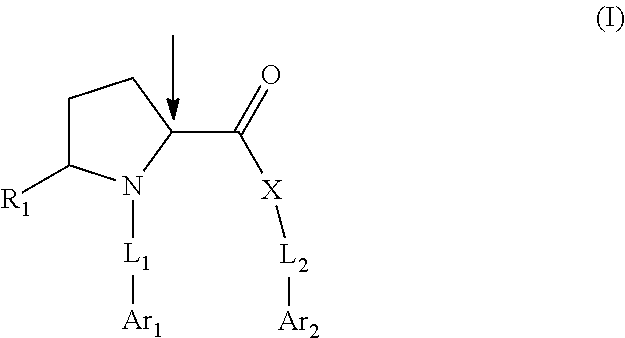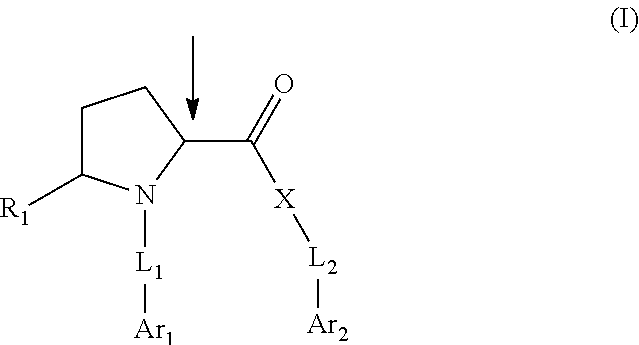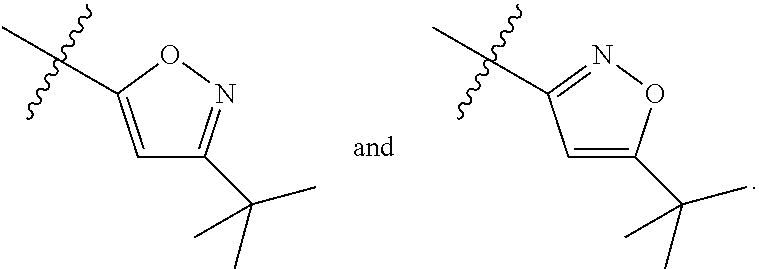Pyrrolidine compounds which modulate the CB2 receptor
a technology of pyrrolidine and receptor, which is applied in the direction of drug composition, immune disorders, extracellular fluid disorders, etc., and can solve the problem of limited therapeutic use of cannabis
- Summary
- Abstract
- Description
- Claims
- Application Information
AI Technical Summary
Benefits of technology
Problems solved by technology
Method used
Image
Examples
example 1
Synthesis of 1-(3-chloro-5-trifluoromethyl-pyridin-2-yl)-pyrrolidine-2-carboxylic acid (5-tert-butyl-isoxazol-3-yl)-amide
[0120]
Step 1: Synthesis of (S)-2-(5-tert-butyl-isoxazol-3-ylcarbamoyl)-pyrrolidine-1-carboxylic acid tert-butyl ester
Coupling Method A:
[0121]To a slurry of N-(tert-butoxycarbonyl)-L-proline (0.5 g; 2.323 mmol) and 3-amino-5-tert-butylisoxazole (0.228 g; 1.626 mmol) in pyridine (9.3 mL; 2.323 mmol) at 0° C. is added phosphorous oxychloride (0.213 mL; 2.323 mmol). The mixture is stirred at 0° C. for 30 minutes and then diluted with water and extracted with ethyl acetate several times. The organics are combined and washed with water and brine, dried (Na2SO4), filtered and concentrated in vacuo to provide the title compound. ESI m / z 338 [M+H]+
[0122]While this represents one method of amide bond coupling, several others were used. The following are general coupling methods used to make intermediates.
Coupling Method B:
[0123]To a solution of acid (0.5 g; 2.323 mmol) in a...
example 2
Synthesis of 1-isopropyl-pyrrolidine-2-carboxylic acid (5-tert-butyl-isoxazol-3-yl)-amide
[0139]
[0140]Step 1 and 2 are the same as Example 1 using coupling method A.
Step 3: Synthesis of 1-isopropyl-pyrrolidine-2-carboxylic acid (5-tert-butyl-isoxazol-3-yl)-amide
[0141]A solution of acetone and (S)-pyrrolidine-2-carboxylic acid (5-tert-butyl-isoxazol-3-yl)-amide; hydrochloride (0.2 g; 0.843 mmol) in dichloroethane (3 mL) with several drops of acetic acid and approximately 10 equivalents of sodium bisulfate is stirred for 30 minutes followed by the addition of sodium cyanoborohydride (0.079 g; 1.265 mmol). The mixture is stirred overnight at room temperature. After this time, the mixture is diluted with ethyl acetate and washed with aqueous sodium bicarbonate solution and brine. The organics are dried (Na2SO4), filtered and concentrated in vacuo to afford crude material. Excess starting material is removed using polystryrene bound-isocyante resin (500 mg: 1.51 mmol / g) in dichloromethane...
example 3
Synthesis of (S)-1-(4-trifluoromethyl-phenyl)-pyrrolidine-2-carboxylic acid (5-trifluoromethyl-pyridin-2-yl)-amide
[0143]
Step 1: Synthesis of (S)-1-(4-trifluoromethyl-phenyl)-pyrrolidine-2-carboxylic acid
[0144]A reaction vessel containing L-proline, 4-trifluoromethylbenzenebromide, potassium carbonate and copper iodide is evacuated and purged with argon several times. Dimethylformamide is added and the solution is heated at 90° C. for 4 days in a sealed vessel. After this time, the mixture is cooled to room temperature and diluted with ethyl acetate and water. The two layers are separated and the aqueous is acidified to pH3 using concentrated hydrochloric acid and extracted with ethyl acetate. The combined organics are washed with brine, dried (Na2SO4), filtered and concentrated in vacuo to afford title compound as intermediate which is used crude in subsequent reactions. ESI m / z 260 [M+H]+
[0145]Intermediates in Table 3 are made in a similar fashion.
[0146]
TABLE 3ESIStructureNamem / z (...
PUM
| Property | Measurement | Unit |
|---|---|---|
| temperature | aaaaa | aaaaa |
| temperature | aaaaa | aaaaa |
| temperature | aaaaa | aaaaa |
Abstract
Description
Claims
Application Information
 Login to View More
Login to View More - R&D
- Intellectual Property
- Life Sciences
- Materials
- Tech Scout
- Unparalleled Data Quality
- Higher Quality Content
- 60% Fewer Hallucinations
Browse by: Latest US Patents, China's latest patents, Technical Efficacy Thesaurus, Application Domain, Technology Topic, Popular Technical Reports.
© 2025 PatSnap. All rights reserved.Legal|Privacy policy|Modern Slavery Act Transparency Statement|Sitemap|About US| Contact US: help@patsnap.com



